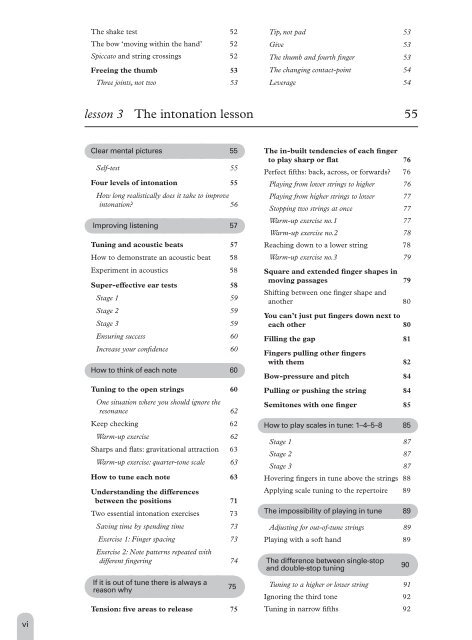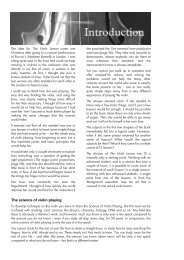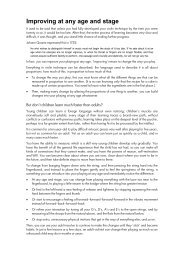here - Secrets of tone production DVD Simon Fischer violin basics
here - Secrets of tone production DVD Simon Fischer violin basics
here - Secrets of tone production DVD Simon Fischer violin basics
- No tags were found...
You also want an ePaper? Increase the reach of your titles
YUMPU automatically turns print PDFs into web optimized ePapers that Google loves.
The shake test 52The bow ‘moving within the hand’ 52Spiccato and string crossings 52Freeing the thumb 53Three joints, not two 53Tip, not pad 53Give 53The thumb and fourth finger 53The changing contact-point 54Leverage 54lesson 3 The intonation lesson 55Clear mental pictures 55Self-test 55Four levels <strong>of</strong> intonation 55How long realistically does it take to improveintonation? 56Improving listening 57Tuning and acoustic beats 57How to demonstrate an acoustic beat 58Experiment in acoustics 58Super-effective ear tests 58Stage 1 59Stage 2 59Stage 3 59Ensuring success 60Increase your confidence 60How to think <strong>of</strong> each note 60Tuning to the open strings 60One situation w<strong>here</strong> you should ignore t<strong>here</strong>sonance 62Keep checking 62Warm-up exercise 62Sharps and flats: gravitational attraction 63Warm-up exercise: quarter-<strong>tone</strong> scale 63How to tune each note 63Understanding the differencesbetween the positions 71Two essential intonation exercises 73Saving time by spending time 73Exercise 1: Finger spacing 73Exercise 2: Note patterns repeated withdifferent fingering 74If it is out <strong>of</strong> tune t<strong>here</strong> is always areason why75Tension: five areas to release 75The in-built tendencies <strong>of</strong> each fingerto play sharp or flat 76Perfect fifths: back, across, or forwards? 76Playing from lower strings to higher 76Playing from higher strings to lower 77Stopping two strings at once 77Warm-up exercise no.1 77Warm-up exercise no.2 78Reaching down to a lower string 78Warm-up exercise no.3 79Square and extended finger shapes inmoving passages 79Shifting between one finger shape andanother 80You can’t just put fingers down next toeach other 80Filling the gap 81Fingers pulling other fingerswith them 82Bow-pressure and pitch 84Pulling or pushing the string 84Semi<strong>tone</strong>s with one finger 85How to play scales in tune: 1–4–5–8 85Stage 1 87Stage 2 87Stage 3 87Hovering fingers in tune above the strings 88Applying scale tuning to the repertoire 89The impossibility <strong>of</strong> playing in tune 89Adjusting for out-<strong>of</strong>-tune strings 89Playing with a s<strong>of</strong>t hand 89The difference between single-stopand double-stop tuning90Tuning to a higher or lower string 91Ignoring the third <strong>tone</strong> 92Tuning in narrow fifths 92vi






